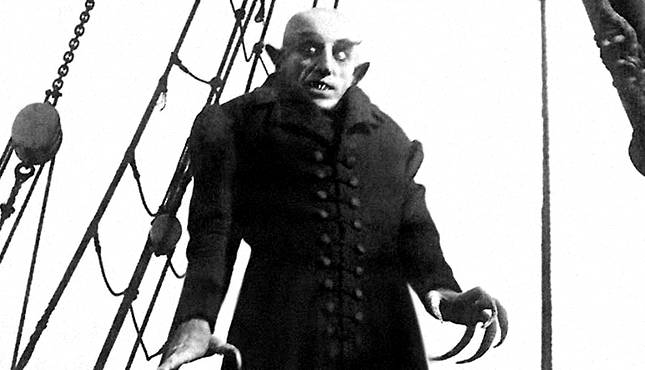Movies & TV / Reviews
Blast From The Past: Nosferatu (1922) Review
 Image Credit: Prana Films
Image Credit: Prana Films
I’m not really sure how I feel about Robert Eggers yet.
For transparency’s sake, I have not seen The Lighthouse, meaning I have missed out on a total of one-third of his filmography. I don’t really have anything against The Lighthouse, it just doesn’t sound like my kind of movie. I need a little bit more to my films than farting and masturbating. That’s what everyone tells me about The Lighthouse, anyway.
But of his other two movies, I’m split. I really enjoyed The VVitch. I thought it was brilliantly acted and very tense. It had a tremendous atmosphere, and the heaviness of the story grew and grew across its palatable runtime. I genuinely think it was a top shelf horror effort from the 2010’s.
Alternatively, I saw The Northman, and I just thought it was fine, at best. It felt overlong and unimpressive as a story. I know it’s simply a predecessor to Hamlet, and that’s great. But it wasn’t anything I was wow’ed by at any point. It wasn’t bad or anything as far as I am concerned, but it just kind of was there with its weird nonsense story.
Despite all of this, I have long been excited for Eggers’ upcoming Nosferatu remake. It has a great trailer, and it allows Eggers to focus on what I feel he does best: lower-tiered, grounded horror, and not big bombastic action. And probably not jerking off while fantasizing about mermaids. But again, who knows? I might love that movie if I see it, ha!
I do like Eggers as a horror guy, though, is the point, so his take one the classic vampire tale? Give it to me!
But you know what else I’ve never seen besides The Lighthouse? The original Nosferatu! Having recently watched a hundred year-old movie, why not go EVEN OLDER, you know? It’s one of the oldest, most noteworthy horror flicks of all time, and it’s time I checked it out.
Nosferatu is… well, have you seen almost any telling of the story of Dracula? It’s that. It’s actually surprising to me that in the earlier days of film, they still released the Universal horror version of Dracula within a decade of this having come out. There are differences, sure, but they are basically the same tale.
And that tale is of a young man named Hutter being sent to Transylvania to seal a real estate deal with the vampiric Count Orlock. Hutter leaves behind his bride, Ellen, who pines for her husband while he is away.
Orlock feeds off of Hutter and captures him in his castle, but does not kill him. Then he makes the way from Transylvania to… I want to say Germany… to claim the property he purchased from Hutter.
As he arrives, it is believed his arrival is spreading a plague due to all of the dead bodies in his wake! And Hutter tries to beat him back home so he can save his bride from Orlock’s machinations.
TWO UPS AND TWO DOWNS
+ So the version of Nosferatu that I had access to was apparently not the original version, as the orchestral backing to the original has been lost to time. However, there have been reissues with newly adapted orchestral scores, and that is what I have watched, and it’s what I want to talk about here.
The score that I heard as I watched Nosferatu was fantastic! It matched the goings-on of the movie perfectly, and every instrument, every beat, every note was perfectly inspired by what was going on on screen. It enhanced every little detail, and it was positively ideal to be matched with the movie.
I’ve definitely seen movies with top-shelf scores before, but I’m not sure I’ve seen any where the score was as important or powerful as it was here.
+ Another aspect of the version of Nosferatu that I saw that apparently was not a part of the original is the use of colored filters over scenes to delineate the differences between morning, day time, and night. Whereas apparently the original was straight black-and-white, the iteration I watched used these filters to clue the viewer in to what time of day it was, as well as what amount of peril there is.
I found this to be supremely effective! It was a very clever addition to the film that, instead of fully colorizing all of it, allows it to maintain its original integrity while also guiding the viewer and creating emotional resonance with it.
– At just a hair over 90 minutes, Nosferatu isn’t overlong by any stretch, but it does meander a bit in its third and fourth acts when we get the whole subplot of the natives of Hutter’s hometown thinking a plague has arrived and chasing Orlock’s minion about town.
It just doesn’t feel super necessary to the rest of the plot, and it kind of wastes time as we wait to see the final confrontation between Orlock, Hutter, and Ellen.
– This is a similar down I gave recently to my first time viewing of the original Candyman: there’s just not enough of the titular character! In the case of both Candyman and Nosferatu, the villain at the heart of the film is so engrossing and striking, I couldn’t help but want more of him!
And I get it… despite the name of the film, this is Hutter’s story about getting home and saving his wife from danger–also, if I may interject here: I respect this 1922 story for giving the female character agency over her own fate, as she saves the day herself!–and not Orlock’s. But I could have used a little more of him. Max Schreck played Orlock so marvelously, I couldn’t help but need more screentime from him.








